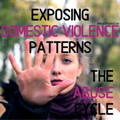Understanding Domestic Violence Patterns
🎯 Every year American women report over 2 MILLION injuries from intimate partner violence.
🎯 1 in 3 women in the United States reports experiencing violence by a current or former spouse, boyfriend or intimate partner at some point in her life.
🎯 Domestic Violence Hotlines receive an average 20,000 calls a day.
Why don’t they just leave the toxic and abusive relationship? Why do they continue putting their lives in danger? In order to answer these questions, you need to understand the cycle of abuse.
“The Cycle of Abuse is eerily predictable in domestic violence according to Dr. Lenore E. Walker ”
THE CYCLE OF ABUSE
The Cycle of Abuse model was introduced to the psychology world by Dr. Lenore E. Walker in 1979 and has become the most established model to explain the predictable way violence in a relationship plays out more often than not.

1. TENSION BUILDING PHASE

2. INCIDENT PHASE

“Research has shown, the average domestic violence survivor experiences violence 7 times before leaving her abuser.”
3. RECONCILIATION PHASE

The key to the Reconciliation Phase is understanding the motives of the abuser. It has nothing to do with making things right with you. It’s all about making it right with himself- His need to reconcile the horrible actions they just committed with the conscience they now feel, after their rage.
4. CALM PHASE
The calm phase (also called the Honeymoon Phase) is the last phase of the abuse cycle. Everything returns to normal and it’s as if the abuse never happened. This is the time when you, as the victim, my start second guessing yourself and making excuses for his behavior.
Here are some examples of things that occur in the Calm Phase of the abuse cycle.
✔️ Your partner may be extra attentive and “the good man” you imagined him to be.
✔️ The abuser is typically on his very best behavior during this phase.
✔️ It’s common for victims to begin second guessing their own feelings, and making excuses for the abuser’s behavior.
✔️ You may convince yourself that this was a one-time incident.
✔️ You may decide to put it behind you and move forward with even more conviction to make the relationship work or to “fix him”.
You may seek out a professional therapist for couples counselling (and he may agree to go initially!)
✔️ The relationship seems almost perfect.

Unfortunately, if the root problem: The abuser’s need for power and control over the relationship isn’t addressed and healed- the Cycle of Abuse will repeat. Research has shown, the average domestic violence survivor experiences violence 7 times before leaving her abuser.
Here are some of the ways that an abuser may try to gain power and control over you in a toxic relationship. Do any of these look familiar? If so, seek professional guidance on how to exit the relationship safely. The most dangerous time in an abusive relationship is when the victim is planning to leave. The National Coalition Against Domestic Violence can guide you in the safest way to do so.
For anonymous, confidential help, 24/7, please call the National Domestic Violence Hotline at 1-800-799-7233 (SAFE) or 1-800-787-3224 (TTY).
METHODS USED TO GAIN POWER & CONTROL
USING INTIMIDATION
· Intimidating looks, actions or gestures
· Destroying your property
· Abusing pets
· Displaying weapons
USING ISOLATION
· Isolation can also take the form of a complete lack of privacy and personal boundaries.
· Controlling who your friends are
· Checking your text messages or phone log
· Limiting her outside involvement
· Selling her on moving away from her network of family and/or friends.
USING YOUR CHILDREN
· Making her feel guilty about her children.
· Involving the children in arguments
· Using the children to relay messages
· Threatening to take the children if she leaves him.
USING FINANCES
· Causing her to lose her job
· Preventing her from keeping or getting a job.
· Giving her an allowance.
· Making her ask for money.
· Taking her money.
· Intentionally keeping her in the dark about family finances and income.
USING EMOTIONAL ABUSE
· Gas lighting to get a reaction from you
· Derogatory comments on your physical appearance
· Making jokes about your intelligence.
USING MANIPULATION
· Making her think she’s crazy
· Twisting the abuse around to make it out to be all her fault.
· Flat out denial that the abuse happened.
· Shifting responsibility.
· Withholding a sincere and authentic apology as a second form of further abuse.
USING MALE PRIVILEGE
· Making all the big decisions without consulting her.
· Master of the Castle attitude
· Treating her like his servant.
USING THREATS/EXTORTION
· Making threats to do something to hurt her.
· Holding something over her head to keep her from reporting the abuse.
· Making her drop charges.
· Making her do illegal things that can be used for extortion later to keep her under his control.
· Threatening to child protective services on her if she leaves.
IMPORTANT STUFF
We cannot stress this enough: If you see any of the above tactics playing out in your relationship, there is help available. Only 34% of people who are injured by intimate partners receive medical care for their injuries. This tells us that the statistical numbers, as shocking and horrific as they seem, are actually even higher than what is reported.
The most dangerous time in an abusive relationship is when the victim is trying to leave the attacker. Seek professional guidance on the safest process for your specific situation and involve the police to ensure a safe exit strategy.
Protect yourself today from domestic violence. At Defense Divas®, we offer a diva-fantastic selection of self-defense products for women, including Bulletproof Clothing, Backpacks & Accessories, Stun Guns, Pepper Sprays, TASER® devices, Concealed Carry Purses, and more.
Copyright©2019 All rights reserved. This article or any portion thereof may not be reproduced or used in any manner whatsoever without the express written permission of the author.
References
https://www.futureswithoutviolence.org/
https://www.socialsolutions.com/blog/domestic-violence-statistics-2018/
https://www.cleverism.com/cycle-of-abuse/
https://www.thehotline.org/is-this-abuse/why-do-people-stay-in-abusive-relationships/
https://www.verywellmind.com/how-to-help-a-victim-of-domestic-violence-66533
https://www.joinonelove.org/learn/why_leaving_abuse_is_hard/


